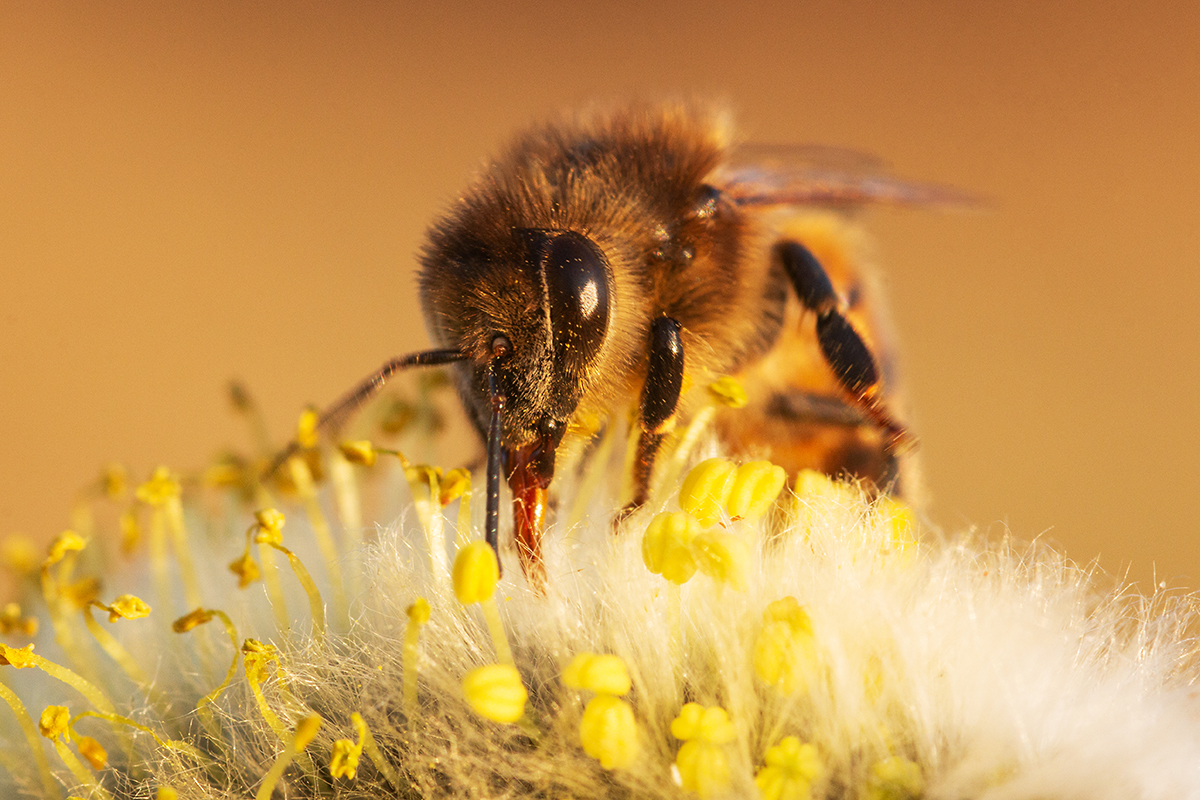The diversity of our food depends largely on the existence of pollinators

Pollinators are insects or other animals that, by carrying pollen from the anthers to the stigma, pollinate the plant, and thus allow the plants to bear fruit. Pollinators include bees, bumblebees, butterflies, flies, and beetles, as well as birds, rodents, and bats. It is estimated that there are more than 20,000 different types of pollinators worldwide [1].
Pollinators are important for the production of many food items for humans: fruits and vegetables, nuts, seeds, coffee, cocoa, and many others need pollinators to ripen. About 90% of the world’s flowering plant species and 75% of the world’s crop production depend on them, so the diversity of our food depends largely on the presence of pollinators [2].
The current rate of species extinction is 100 to 1,000 times higher than natural extinction, and that is due to human activities. Of the invertebrate pollinator species – the most important of which are bees and butterflies – about 40% are at risk of extinction. The reasons for this are land use and landscape change, intensive agricultural practices, monocultures, and the use of plant protection products and toxins. Pollinators’ habitats have become fragmented or even destroyed, and globalisation has led to the faster spread of diseases. Pollinators are also affected by climate change – higher temperatures, droughts, floods, and other extreme climatic events affect the flowering of plants and thus the lives of pollinators [3].
Changes in agricultural practices have led to the use of more pesticides and toxins. In the case of intensive agriculture, the use of plant protection agents is essential – farmers use them to protect their crops. Unfortunately, insecticides kill not only pests, but also pollinators and other beneficial insects, including the natural enemies of pests. At the same time, farmers depend on pollinators in the cultivation of many crops (such as fruit and legumes).
Toxins affect the number and diversity of pollinators and can affect bees, bumblebees, and other pollinators directly (through insecticides and fungicides) or indirectly (through herbicides) [4]. They may also act in ways that are invisible to the naked eye, such as inhibiting the learning and orientation skills of pollinating insects, resulting in situations where bees may no longer find their way home or to food [5].
There are a number of mitigation measures to reduce the impact of intensive agriculture. For example, the need for pest control can be prevented by crop rotation, which interrupts the development cycles of different pests and reduces their numbers, as well as sowing plants that are pleasant to pests near the fields and then destroying the pests that have accumulated. Hedges should be planted around the fields or flowering plants should be sown between the fields, where pollinators can feed and where pest-limiting insects can live. The use of plant protection products must respect the boundaries of the field and the minimum amount of pesticides required must be used, thus reducing the need for it [6].
Researchers have concluded [7] that the disappearance of bees would have frightening and far-reaching consequences. Without them, the world would be a completely different place – apart from the fact that there would be no more honey to eat or use in the medical and cosmetic industries, many other major changes would follow. About half of the goods in grocery stores would disappear (many fruits, coffee, cocoa, also cotton fabrics), and as cows, sheep, and goats eat bee-dependent plants, many meat and dairy products would disappear from our diet as well. Plants that are less dependent on bees would remain, such as wheat, corn, soy beans, and rice, as well as potatoes, tomatoes, and carrots. Food prices would rise and people would face a number of health problems as a result of the impoverishment of their diet.
Last modified: 12.01.2022
_________________________________________
[1] The IPBES global assessment report on biodiversity and ecosystem services, Secretariat of the Intergovernmental Science. Policy Platform on Biodiversity and Ecosystem Services. IPBES, Bonn, Germany, 2019
[2] http://www.fao.org/pollination/background/bees-and-other-pollinators/en/
[3] What’s behind the decline in bees and other pollinators?
[4] D. A. Stanley, et al. Bumblebee learning and memory is impaired by chronic exposure to a neonicotinoid pesticide. Sci. Rep. 5, 16508; doi: 10.1038/srep16508 (2015); M. Himma. Taimekaitsevahendid pärsivad mesilaste õppimisvõimet. Novaator, 11.07.2018.
[5] Intensiivpõllumajandus vajab, kuid hävitab tolmeldajaid. Eesti Loodus 4/2008.
[6] The methodological assessment report on scenarios and models of biodiversity and ecosystem services. S. Ferrier, K. N. Ninan, P. Leadley, R. Alkemade, L. A. Acosta, H. R. Akcakaya, L. Brotons, W. W. L. Cheung, V. Christensen, K. A. Harhash, J. Kabubo-Mariara, C. Lundquist, M. Obersteiner, H. M. Pereira, G. Peterson, R. Pichs-Madruga, N. Ravindranath, C. Rondinini and B. A. Wintle (eds.). Secretariat of the Intergovernmental Science-Policy Platform on Biodiversity and Ecosystem Services, Bonn, Germany, IPBES, 2016.